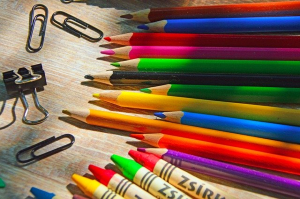
By Sarah Green, Family Liaison Officer/Prevention Support & Intervention Worker
1. What are some of the common stressors kids feel when they start back to school?
• A change in routine. Transitioning from “summer schedule” back to “school schedule” can cause stress and anxiety for kids. This can often be exacerbated if parents are feeling this stress too. As parents, we can unintentionally transfer our stress of not being ready on time or running late, onto our children. This is why it is often suggested to either slowly shift back into “school schedule” or at least try the week before to alternate bedtimes and wake ups to be closer to what children will expect in the school year.
• A change in environment. Some children may feel excitement about being in a new place or somewhere different from their house, that they have been in over the summer (or longer this year due to COVID-19). Some children may have developed coping strategies or ways of calming and relaxing themselves that are specifically connected to an environment like their room or their house. Similarly, chances are they are in a different classroom or area of the building than the previous school year. Things like not knowing where the bathroom is in relation to their classroom can cause a lot of worry and concern for children.
• Participating in class. For some children, returning to school can cause anxiety when thinking about having to participate in the classroom. This can be particularly stressing if children are not comfortable speaking in front of others, or are not confident in the subject being discussed. Often children are asked to participate by raising hands and speaking out loud or being called upon. The anticipation of being called on or not raising their hand because they don’t know something can cause a child anxiety and to feel singled out.
• The “What did you do this summer?” Question. Many teachers have pivoted away from asking this question, recognizing that not all children have the ability to do something in the summer that they would be excited to share. This doesn’t mean that other kids and classmates won’t still ask. Especially with COVID-19, some children’s families may have had the financial ability to buy fun new toys or get all the latest technology/games during the time at home. Some families may have experienced the loss of their job, or lack of daycare and some kids may have had to go to work with their parents. Children can be stressed or worried about what they will say when asked this or when thinking about how their summer or COVID-19 experience compared with others. This can also cause anxiety about how others will view them when they provide their answer.
2. What additional stressors will kids possibly feel this year?
• Will my friends still like me? The COVID-19 pandemic has resulted in many kids and children losing touch with their friends or former classmates. This can typically happen over the summer, however it may be increased this year. This could be due to the lack of ability to see each other physically, or different family rules regarding electronics and social media. Kids may feel that they have “missed out” on inside jokes or plans with people who they used to feel close to. When returning to school and seeing their friends again they may fear or worry that their friends won’t like them anymore, or will have found new friends.
• Getting in trouble. This can be a common stressor or concern every school year as children see a change in authority figure from parent(s) to teacher. It may be increased this year with new rules and regulations surrounding COVID-19. Kids may have been told different things about COVID-19, but they are likely all aware of it. They may have been given strict instructions about masks and how to behave. They may feel scared or worried about breaking these additional “rules”.
3. How can teachers help to ease kid’s stressors?

• Take the children on a tour of the school within the first week of school (ideally day one). Even if the children have all been in the school before, being in a new classroom means that the path from the classroom to the bathroom may now be different. This is especially helpful for visual learners, and it avoids the need for a child to be singled out by needing an adult, teacher or staff member to walk them to the bathroom if it is not required. In addition, this may be beneficial if there are new arrows and sides of the hallway to walk on as a result of COVID-19 precautions.
• Offer different ways for children to participate in class. Allow children the option of sharing out loud, writing things down, drawing something out or even acting out their answers through props or objects in the room. Even knowing that there are options they can choose based on their comfort level can help reduce stress and anxiety.
• Ask the class or students what will make them feel safe in the classroom this year (options for anonymity may be a benefit!). This could be related to COVID-19 and physical safety or emotional safety. Ask things like what can I do to make you feel safe, comfortable or happy? What can your classmates do to make you feel safe, comfortable or happy? Letting them know ahead of time not everything they suggest will be possible, but that you want to listen to them and can help in providing them some sense of control.
4. How can parents help kids deal with stressors?
• In transitioning back into a “school schedule” parents can often find themselves feeling anxious themselves especially as they try to get everyone out the door with all their gear, get the kids to school on time and then get themselves to work. Try providing timeframes and deadlines for the kids and start this early! Let them know on school days we need to leave the house at 8:00 or we need to be in the car at 7:30. Then ask them what they will need to be able to be ready by that time. If a child wants to take 20 minutes to eat breakfast, they can do that, but they need to plan to be up in time to do that. Involving kids in planning can help them feel more in control and confident!
• Sit down and make a plan with kids about what they will do if they feel different emotions throughout the school day/week. If they start to feel anxious, sad, scared, mad etc at school what can you do? Who can you talk to? You can even write this down together or create a document for them to keep in their bag that they can refer to. Not knowing what to do can increase stress and anxiety and having the security of knowing what to do or at least what to try to help with the emotions can help reduce them. It may even be helpful to share this plan with the teacher!
• Validate their feelings. Children are continuing to learn about emotions and feelings and how they experience them. By validating them we can teach them that it is okay to feel that way and help them learn what to do. It can also help them feel more understood and closer to you. Try validating by saying things like “I get why you would feel _____ because… (provide a few reasons) or It makes sense that you’re feeling this way because…(provide a few reasons).
Alternate ways to start: “I can see how that might make you feel _____”, “No wonder you’re feeling _____” or “I can understand why you might feel this way because….”
• Trading “but” for “and”. Trying to get children to complete tasks or follow instructions can be challenging, especially in starting a school year. Getting up for school, doing homework, finishing chores, stopping the TV etc. Often we try and use the validation techniques above, but end up invalidating children by using the word “but”. For example “I understand why you are feeling anxious about going to school when you haven’t seen your friends in a while, you have to wear a mask and you don’t know where your classroom is. But you still have to go”. In changing from saying “but you still have to go” to something like “and it is still something that has to be done” allows both things to exist at the same time. I can be worried, anxious and nervous about going to school AND I still have to go. So what can we do together to get this task accomplished?
• Here is an excellent video from Anxiety Canada that helps explain anxiety to children https://www.anxietycanada.com/articles/fight-flight-freeze-anxiety-explained-for-kids/
5. What are some of the signs parents, teachers, and other students can watch for?

• Unusual changes in behaviour–becoming withdrawn, not participating in things they normally love or enjoy)
• Avoidant behaviours–trying to find reasons to not talk about school or friends or avoid interacting with school or friends
• Expressing negative or worried thoughts–or an increase in these kinds of thoughts
• They may want to spend an increased time with parents or want to distance themselves from parents
• Quicker to experience emotions (and often at a higher level)
• Their usual coping skills or ways of managing anxiety or stress are not working
o This could be due to change in environment and not having the same ability to use them or it could be an indicator of increased stress and anxiety
6. Anything else you’d like to add?
• Children can often blame themselves for things they see happening around them. If they notice that their parents are more stressed or fighting they can make their own assumptions about why. It can be helpful to speak to children about behaviours or actions they may have seen. For example if they notice a parent being distracted and hurriedly saying “Not now, I have to get this done” or “I don’t have time for this”, children can then think it is their fault that their parents don’t have time for something. Sitting down with children and expressing that you may also be experiencing stress, however it is not their fault can be really beneficial. It can also help if you share with them how you handle stress or what you do to feel more calm and relaxed. This can then lead to you engaging in some coping strategies together!
The free Smiling Mind App (https://www.smilingmind.com.au/ )helps children, teenagers, and adults deal with anxiety by providing 5, 10, 15 minute mindfulness sessions geared to the age of the listener. It can also assist with relaxation and sleep. You just download it to a phone or computer, put in the age of your child and choose what you want the session to do – deal with anxiety, relaxation, sleep etc.
